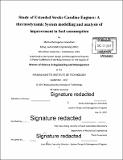| dc.contributor.advisor | Wai Cheng. | en_US |
| dc.contributor.author | Anandhan, Muthu Mailvaganan | en_US |
| dc.contributor.other | System Design and Management Program. | en_US |
| dc.date.accessioned | 2018-03-12T19:29:15Z | |
| dc.date.available | 2018-03-12T19:29:15Z | |
| dc.date.copyright | 2017 | en_US |
| dc.date.issued | 2017 | en_US |
| dc.identifier.uri | http://hdl.handle.net/1721.1/114085 | |
| dc.description | Thesis: S.M. in Engineering and Management, Massachusetts Institute of Technology, System Design and Management Program, 2017. | en_US |
| dc.description | Page 102 blank. Cataloged from PDF version of thesis. | en_US |
| dc.description | Includes bibliographical references (page 92). | en_US |
| dc.description.abstract | This thesis studies the benefit and challenges of using an extended stroke engine on the automotive application. For the purpose of the study, a one-dimensional thermodynamic model was built using the GT- Power software. GM LNF 2.0 liter engine was used as the candidate of study, the base model was originally developed in Sloan auto lab, and this model was used and modified for the purpose of the extended stroke operation. The study was conducted to understand the improvement in indicated specific fuel consumption (ISFC) and the net indicated efficiency of the system at various speed and load points of operations. The crank train dimensions built by Dr. Matthias Brendel, as part of his Phd dissertation, was used for the purpose of this study. The study indicates that extended stroke operation offers an ISFC reduction of about 8% at the higher loads of operation such as 20 bar of indicated mean effective pressure (IMEP). The reduction in ISFC comes down at the lower loads, and at lower IMEPs extended stroke operation shows negative ISFC reduction. This is due to over expansion loss incurred by the extended stroke operation. This study has also revealed that extended stroke engine has much higher knock resistivity due to higher volume presence at any given crank angle this allows the extended stroke engine to require less spark retard; hence, this type of engine can afford to operate at lower compression ratios and still achieve the better thermal efficiency. The extended stroke engine's behavior at lower loads indicate that there loss of efficiency up to 2% due to negative loop in the PV diagram and it also indicates that there is an increase in pumping loss in general at loads. Valve timing studies conducted to recover this loss show no significant improvement without a total change in the valve-timing phase. The effect of exhaust gas recirculation was also conducted and the extended stroke engine nearly the same way as that of base engine, however the increase in pumping loss from the extended stroke operation doesn't allow the higher stroke ratio operations to have significant increase in indicated efficiency due to EGR. The pumping loss does come down but at lesser magnitude. This indicates that the EGR could be used to mitigate the increase in pumping loss of extended stroke operation. The study with turbo-limited performance of the extended stroke engine indicates that the extended stroke engine will develop less power at any given speed due to limiting of the airflow. This is essentially one of the limitations of the extended stroke operation. Finally, the thesis concludes by pointing out the potentials and challenges of the extended stroke operation engine. | en_US |
| dc.description.statementofresponsibility | by Muthu Mailvaganan Anandhan. | en_US |
| dc.format.extent | 102 pages | en_US |
| dc.language.iso | eng | en_US |
| dc.publisher | Massachusetts Institute of Technology | en_US |
| dc.rights | MIT theses are protected by copyright. They may be viewed, downloaded, or printed from this source but further reproduction or distribution in any format is prohibited without written permission. | en_US |
| dc.rights.uri | http://dspace.mit.edu/handle/1721.1/7582 | en_US |
| dc.subject | Engineering and Management Program. | en_US |
| dc.subject | Integrated Design and Management Program. | en_US |
| dc.subject | System Design and Management Program. | en_US |
| dc.title | Study of extended stroke gasoline engines : a thermodynamic system modelling and analysis of improvement in fuel consumption | en_US |
| dc.title.alternative | Thermodynamic system modelling and analysis of improvement in fuel consumption | en_US |
| dc.type | Thesis | en_US |
| dc.description.degree | S.M. in Engineering and Management | en_US |
| dc.contributor.department | Massachusetts Institute of Technology. Engineering and Management Program | en_US |
| dc.contributor.department | System Design and Management Program. | en_US |
| dc.contributor.department | Massachusetts Institute of Technology. Integrated Design and Management Program | en_US |
| dc.identifier.oclc | 1027216605 | en_US |
